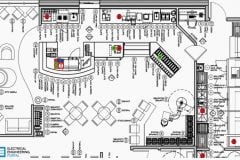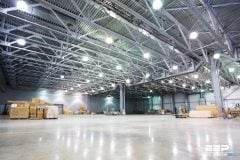
Flexible Lighting Design Solution
Most living rooms require flexible lighting design solutions because they serve a broad variety of changing functions. The lighting in a typical living room should comfortably serve small group conversation, larger social gatherings that include casual eating and drinking, and more solitary activities such as reading, music listening, and TV viewing.
Somewhat less typically, a living room may have a desk or home office corner, a place for card or board games, a major library collection, or an art collection to be prominently displayed.
The visual tasks in living rooms range from basic and simple to complex and highly technical, depending on the size and intended purpose of the room.
The typical living room shown below, which is of simple but moderate size and furnished to serve several functions, presents the following visual tasks to be accommodated:
1. Ambient lighting for conversation and social functions
Illumination levels may vary from as little as 7–8 fc to 25–30 fc depending on the desires of people involved. More specifically, critical or extended-period visual tasks are not expected to be performed under these lighting conditions.
2. Task lighting for extended-period visual tasks
In this case, the only task planned for is reading in two locations.
3. Focal light
Focal light is required for the large floor-to-ceiling bookshelves on the east end of the south wall and the north end of the east wall, as well as for graphic material anticipated on the west side of the south wall, the center wall area of the north wall, and above the fireplace mantel.
4. Lighting for television viewing
TV viewing presents unusual lighting require-ments because the rest of the lighting in the living room is unwanted and detrimental for this purpose. If TV viewing is an expected function, the lighting design solution should accommodate it.

The lighting solution shown below addresses the visual tasks in the following manner:
[dropcap2]T[/dropcap2]he need and desire for ambient lighting is met by several lighting elements. The sconces on the north wall provide a blanket of light for that side of the room, the intensity of which can be adjusted by the controlling dimmer switch. The portable lighting adds to the quantity and effectiveness of the ambient lighting, with three table lamps and the floor lamp contributing primarily to the conversation area at the west end of the room.
While their contribution is secondary to those mentioned above, the five wallwashers and three accent luminaires represent still another element of ambient light.
The many luminaires in the room (14 fixed and 4 portable), call for many ways of adjusting the quality of ambient light by selecting those to be turned on as well as by adjusting their output through dimmer controls.
[dropcap2]T[/dropcap2]he primary reading chair is positioned in the northeast corner of the room, where the adjacent sconce should serve as an adequate light source. The chairs in the northwest and southwest corners of the room can also serve as reading chairs, with the former receiving light from the adjacent sconces and the latter having a floor lamp nearby.
Depending on the users’ habits, an additional floor lamp can be placed adjacent to the primary reading chair.
[dropcap2]F[/dropcap2]ocal lighting requirements are met with the five recessed wallwashers directed toward the south wall and the three adjustable accent luminaires directed toward the wall above the fireplace mantel, the center area of the north wall, and the shelving/cabinetwork unit at the north end of the east wall.
[dropcap2]T[/dropcap2]elevision viewing presents lighting problems in multipurpose spaces such as living rooms. When TV is viewed in a room or space used primarily for that purpose, creating appropriate lighting is simply accomplished.
In this example, many of the luminaires could create unwanted reflections on the TV screen. The only luminaires that will not adversely affect TV viewing are the wallwashers facing the south wall. If the sconces on the north wall are dimmed for low output, their negative effect could be quite minor.
Adding a floor lamp in the northeast corner of the room would balance the lighting of the room during the viewing period.
Because flexibility in lighting is essential in living rooms, most lighting should be controlled with dimmer switches. With dimmers, the lighting of the room can be adjusted to achieve just the right quality for any occasion.
Sconces: direct-indirect ratio, task (reading) light for adjacent chairs, degree of eye-level glow and/or sparkle.
Wallwahsers: recessed or surface mounted, spread of light (depending on graphics, if known).
Table lamps: direct-indirect ratio, diffuse shade, degree of eye-level glow and/or sparkle.
Floor lamp: direct-indirect ratio, task (reading) light for adjacent chair, diffuse shade, degree of eye-level glow and/or sparkle.
Lamp selection in all cases can be compact fluorescent or incandescent, with wattage based on personal preference.
The design quality or style of the selected luminaires will be determined primarily by the quality or style of the architectural and interior design detailing and materials, from traditional cut glass (sconces) and fringed shades (portables) to contemporary woods, plastics, and metals to high-tech materials.
This element of luminaire selection is difficult to articulate because it deals with the elusive elements of aesthetics, style, and taste.
Only long experience in a trial-and-error process over the course of many projects will inform the designer in making intelligent aesthetic decisions.
Demo of multiple lamps in a living room (VIDEO)
Cant see this video? Click here to watch it on Youtube.
Resource: Lighting design basics – Mark karlen, James R. Benya










